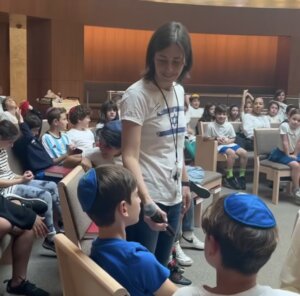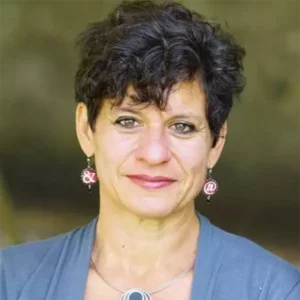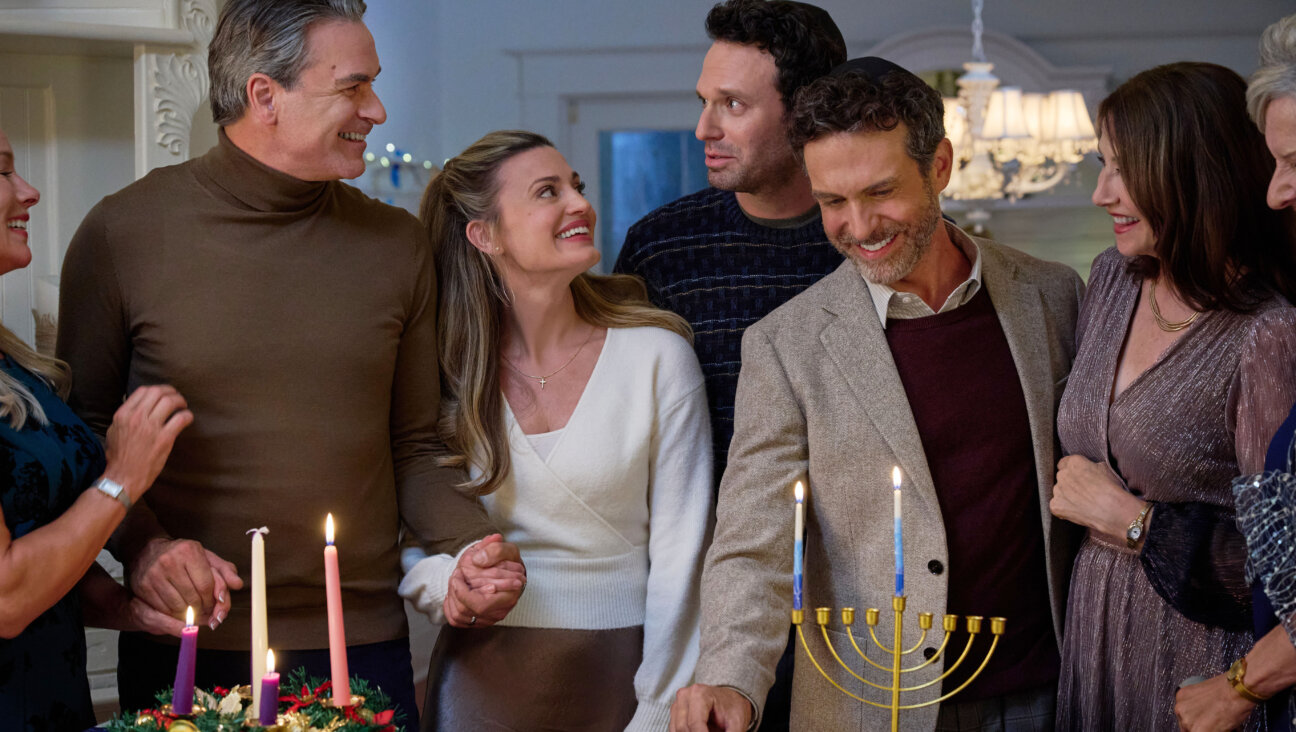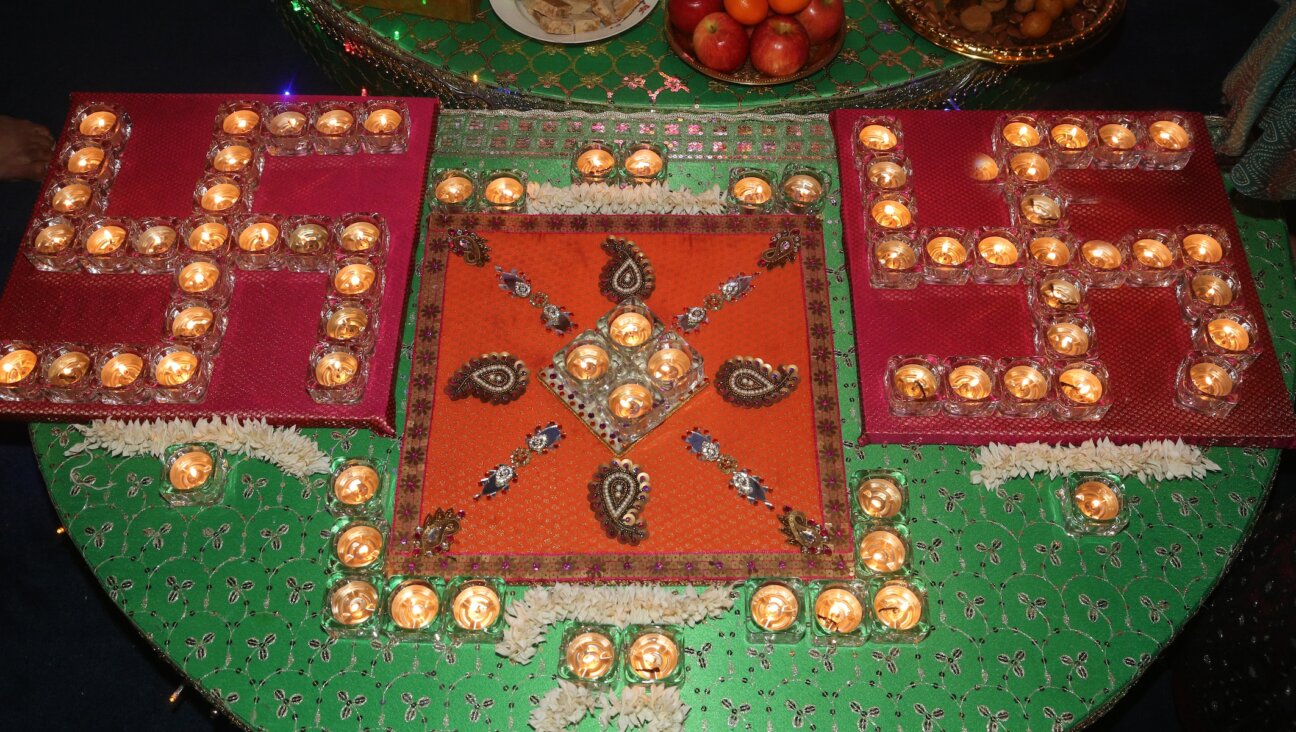6th grade questions about Israel and Gaza, and the teacher who answers them
‘You can’t understand what’s happening now if we don’t do this history’

Graphic by Angelie Zaslavsky
LOS ANGELES — Why are they calling this Israel’s 9/11? Why are they calling this the Second Nakba? How were the borders of Gaza created? How will Israel win?
These were some of the questions a friend got while doing carpool duty the other day for her daughter, a sixth grader at a Jewish day school in LA. She shared them with me because of the columns I’ve done answering kids’ questions about Israel and Gaza, during this war and its 2021 predecessor.
Then she introduced me to Erica Rothblum, who has been answering them pretty much every day for the last seven weeks, as head of the Rabbi Jacob Pressman Academy at Temple Beth Am., a Conservative synagogue on LA’s West Side, and teacher of its sixth grade Israel studies class.
“The thing about sixth graders that I love is that they are old enough to understand complexity, and to ask really interesting questions and have really interesting thoughts,” Rothblum said. ”And they are young enough to still think that the adults in their lives have all of the answers.”
Well, maybe not all the answers. But we try.
The class meets on Tuesdays, which means Rothblum was hit with a barrage the first day back at school after the holiday weekend that included the Oct. 7 terror attack, in which Hamas slaughtered 1,200 people in Israel and abducted another 240. Here are some of the questions she got that day (and, for those beyond her classroom, my answers).
How big is Gaza? Seventeen square miles (about half the size of Manhattan).
What is the name of this war? Hamas dubbed its initial attack Operation Al-Aqsa Flood, referring to the mosque complex built on the Temple Mount; the Israel Defense Forces calls its response Operation Swords of Iron.
Are any of the reservists feeling conflicted about fighting? Certainly. Nobody likes fighting. But the reservists and the soldiers are resolved to protect Israel, and very motivated to rescue the hostages.
Why did Hamas attack now? When will the war end? Is my family in Israel safe? Unanswerable, unanswerable, unanswerable.
“We do our best to break apart what we can and make it as understandable as we can,” Rothblum told me. “The thing I keep coming back to for the kids is that it’s their obligation to understand the history and to understand the complexities. And that if anyone tells them that this is simple, then that is a clear indication that that person doesn’t understand.”
Her school has 500 students in preschool through eighth grade. Most families have what Rothblum called a “primary” connection to Israel — one or both parents who grew up there, relatives who live there and perhaps are now deployed in the army, summer breaks spent there.
Rothblum, who first visited Israel as a high schooler in 1996 and spent her junior year in college at Hebrew University in Jerusalem, was supposed to be taking 20 of the sixth graders to Israel for 10 days starting next Sunday. Instead, she is fielding questions like these (again, the answers are from me):
Answering the answerable
Does Hamas terrorize other countries? No. Hamas was created in 1987 as an offshoot of Egypt’s Muslim Brotherhood and is specifically devoted to the destruction of Israel, as outlined in its charter. Hamas has at various times accepted the idea of a Palestinian state roughly along the pre-1967 borders but has never recognized Israel’s right to exist as a Jewish state. The group’s charter also includes a call to kill Jews generally.
Why is it called Hamas? The name is an acronym for “Islamic Resistance Movement” in Arabic, Ḥarakat al-Muqāwamah al-ʾIslāmiyyah. Hamas is a political organization with an armed wing, the Izzedin al-Qassam Brigades, sometimes called just Qassam.
Did the United Nations take a stance on the situation? The U.N. Security Council passed a resolution Nov. 15 calling for an immediate pause in the fighting to allow humanitarian aid into Gaza, and for the release of all hostages held by Hamas and other armed groups. The United States and Russia both abstained from the resolution, but for different reasons. Russia wanted the Security Council to call for a full cease-fire; the U.S. refused to back anything that did not specifically condemn Hamas’ Oct. 7 attack.
The U.N. General Assembly, meanwhile, passed a nonbinding resolution on Oct. 27 that called for “an immediate humanitarian truce leading to a cessation of hostilities.” Of the body’s 193 members, 120 voted yes. The U.S. and Israel were among 45 abstentions, and Israel’s ambassador, Gilad Erdan, said the resolution left the U.N. with “not even one ounce of legitimacy.”

Is the United States going to fight too? Let’s hope not. Right now the only people directly fighting in the war are the Israel Defense Forces and Palestinian armed groups in Gaza, particularly Hamas. The U.S. is Israel’s strongest ally, and the Biden administration has supported the war with weapons and money. The U.S. also moved two aircraft carrier groups into the Middle East, signaling that our troops could indeed join the battle if it expanded to include other countries in the region, especially Iran. That would be a major change.
The U.S. has also been deeply involved in negotiating the temporary cease-fire and hostage-release deal with Qatar, Egypt and other countries.
Why are they calling this Israel’s 9/11? First, because of the scale: Given Israel’s size, about 9 million people, the estimated 1,200 people Hamas murdered on Oct. 7 is actually the equivalent of about 15 times the impact of the loss of about 3,000 people on 9/11, when the population of the U.S. was 285 million. Perhaps more importantly, the Hamas breach of the Gaza border fence and penetration of Israeli communities shattered core Israeli beliefs about their security in ways similar to the 9/11 terrorists’ hijacking of planes and flying them into the World Trade Center and the Pentagon. Neither society anticipated that type of attack.
Why are they calling this the second Nakba? Nakba, which is the Arabic word for “catastrophe,” is how Palestinians and their supporters refer to the events of 1948, when Israel became a state, and about 700,000 either fled or were forced from their homes inside its borders. Arab allies urged many Palestinian residents to leave; others were pushed out by Israeli soldiers, who also destroyed some Arab villages. Many ended up in the Gaza Strip or West Bank, others in Lebanon, Jordan and Syria. Those who stayed became citizens of Israel.
Some people are calling the current war a second Nakba because an estimated 1.5 million Gaza residents — two-thirds of the total population — have already had to leave their homes in the enclave’s north because of Israel’s bombardment. They may have nothing to return to, given how much of Gaza has been destroyed in the fighting. Others may be using the more general meaning of the term, “catastrophe,” to describe the devastation, high death toll, and humanitarian crisis gripping the territory.
The history informs the now
While the war has indefinitely postponed Rothblum’s class trip to Israel, she said it has been easy to incorporate discussions of it into her curriculum. She always starts each class with a student sharing a current event about Israel.
“It’s funny, because in September, when I first introduced this assignment, one of the kids was like, ‘What if there’s nothing happening in Israel my week?’” she recalled. After Oct. 7 she joked, “Oh, you don’t have to worry about that now.”
Now, after each current event presentation, she asks the group: “OK, what else do you know has happened in Israel in the last week? Tell me five things. What are three questions you guys have about what you’ve heard? We answer those three questions. And then we move on.”
Rothblum’s first unit each fall is history. When the war broke out, the class was deep into 1948 — Israel’s Declaration of Independence, the war around it, and the Palestinian Nakba. When they got to the Yom Kippur War, she asked the students about the similarities with the Oct. 7 attack almost exactly half a century later.
“It wasn’t just the obvious — a surprise attack — but they talked about the Bar-Lev line and they talked about the fence around Gaza,” Rothblum said. (Bar-Lev was the fortification Israel built along the Suez Canal in 1967 that was considered impenetrable — until the Egyptians overran it in 1973. Not unlike the Gaza fence that Hamas terrorists breached on Oct. 7.)
“I had one student say it feels really wrong that we’re talking about something that happened so long ago, when there’s so much to talk about now,” Rothblum noted. “And I said, ‘But you can’t understand what’s happening now if we don’t do this history.’ So we did.
“When we were talking about 1948, I said, ‘So why would you think that people in Gaza are worried that this will be another Nakba?” Rothblum added. “Let’s talk about what they might be experiencing.”
I was impressed with this. Too many Jewish institutions have ignored or downplayed the Palestinian experience and narrative for too long. It’s part of what led a group of graduates of Jewish day schools to create the leftist advocacy group IfNotNow during the Israel-Gaza war in 2014: They felt they’d only heard one side of the story and were shocked to discover it was far more complex.
Rothblum said this is exactly why she teaches about the Nakba.
“We believe, and there is research supporting this belief, that children need to be exposed — in developmentally appropriate ways — to the complexities of Israel in order to be rooted in their Zionism,” she explained. “We believe that kids can hear things that are complex and still love Israel — and in fact, hearing the complexities can make that love and connection even stronger.”

















